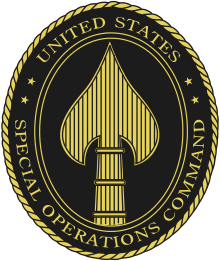SEAL Team Six
The Naval Special Warfare Development Group (NSWDG), commonly known as DEVGRU (DEVelopment GRoUp) or SEAL Team Six,[3][4] is the United States Navy component of the Joint Special Operations Command (JSOC). The unit is often referred to within JSOC as Task Force Blue.[4] DEVGRU is administratively supported by Naval Special Warfare Command and operationally commanded by the Joint Special Operations Command. Most information concerning DEVGRU is classified and details of its activities are not usually commented on by either the Department of Defense or the White House.[5] Despite the official name changes, "SEAL Team Six" remains the unit's widely recognized moniker.
| Naval Special Warfare Development Group | |
|---|---|
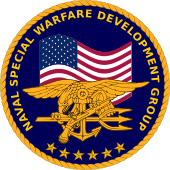 | |
| Active | November 1980 – present |
| Country | |
| Branch | |
| Type | Special operations force Special Missions Unit |
| Role | Counter Terrorism Hostage Rescue Direct Action Special Reconnaissance High Value Targets |
| Size | 1,787 personnel authorized:[1]
|
| Part of | |
| Headquarters | Dam Neck Annex NAS Oceana, Virginia Beach, Virginia, U.S. |
| Nickname(s) | "SEAL Team Six", "DEVGRU", "Task Force Blue", "NSWDG" |
| Engagements | Operation Urgent Fury TWA Flight 847 Hijacking Achille Lauro hijacking Operation Prime Chance Operation Just Cause Operation Desert Storm Somali Civil War
Operation Uphold Democracy
Global War on Terrorism
|
| Unit awards | Presidential Unit Citation[2] |
DEVGRU and its Army and Air Force counterparts, 1st SFOD-D (Delta Force) and 24th Special Tactics Squadron, are the U.S. military's primary Tier 1 Special Mission Units tasked with performing the most complex, classified, and dangerous missions directed by the National Command Authority.[6][7] DEVGRU is a counter-terrorism unit that's multi-functional, with several roles that include hostage rescue, special reconnaissance, direct action against high-value targets, personal security, and other specialized missions.
History
The origins of DEVGRU are in SEAL Team Six, a unit created in the aftermath of Operation Eagle Claw.[8][9][10] During the Iran hostage crisis in 1979, Richard Marcinko was one of two U.S. Navy representatives for a Joint Chiefs of Staff task force known as the TAT (Terrorist Action Team). The purpose of the TAT was to develop a plan to free the American hostages held in Iran. In the wake of the disaster at the Desert One base in Iran, the Navy saw the need for a full-time counter-terrorist unit, and tasked Marcinko with its design and development.
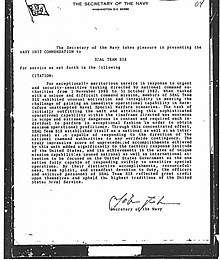
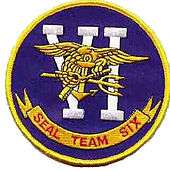
Marcinko was the first commanding officer of this new unit. At the time there were only two SEAL Teams, SEAL Team ONE and SEAL Team TWO. Marcinko named the unit SEAL Team Six in order to confuse Soviet intelligence as to the number of actual SEAL teams in existence.[10][11][12] The unit's plankowners (founding members) were interviewed and hand-picked by Marcinko from throughout the UDT/SEAL community. SEAL Team Six was formally commissioned in November 1980, and an intense, progressive work-up training program made the unit mission-ready just six months later.[12] SEAL Team Six became the U.S. Navy's premier hostage rescue and counter-terrorist unit. It has been compared to the U.S. Army's elite Delta Force.[5][9] Marcinko held the command of SEAL Team Six for three years, from 1980 to July 1983, instead of the typical two-year command in the Navy at the time.[10] SEAL Team Six started with 75 shooters. According to Marcinko, the annual ammunition training allowance for the command was larger than that of the entire U.S. Marine Corps. The unit has virtually unlimited resources at its disposal.[13] In 1984, Marcinko and a dozen members of SEAL Team Six would go on to form "Red Cell" (also known as OP-06D), a special unit designed to test the security of American military installations.
In 1987, SEAL Team Six was dissolved. A new unit named the "Naval Special Warfare Development Group" was formed, essentially as SEAL Team Six's successor.[3][14][15] Reasons for the disbanding are varied,[10] but the name SEAL Team Six is often used in reference to DEVGRU.
Recruitment, selection and training
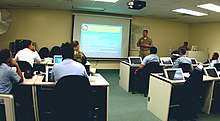
In the early stages of creating SEAL Team Six, Marcinko was given a six-month window to produce the team. Had he failed to do so, the project would have been cancelled. Consequentially, Marcinko had little time to create a proper selection course on par with Delta Forces' process. To get around this, recruits were selected after assessing their Navy records, followed by individual interviews. Marcinko has indicated he would have preferred more time to perform the selection process.
Originally, applicants only came from the east and west coast SEAL teams and the UDTs. Although much of the ST6/DEVGRU training pipeline is classified, there are some requirements and training exercises that are public knowledge. The requirements to apply for DEVGRU states that applicants must be male and come from the SDV teams, the Special Boat teams or SWCC, the Navy explosive ordnance disposal teams (EOD teams) and East/ West Coast SEAL teams, be 21 years old or older, and have at least served two combat tours on their previous assignments. Although, due to the combat experience requirement, it is not uncommon for a candidate to be in his early 30s. Marcinko's criteria for recruiting applicants was combat experience so he would know they could perform under fire; language skills were vital to communicate with the local population if needed, as the unit would have a worldwide mandate; union skills, to be able to blend in as civilians during an operation; and finally SEAL skills. Members of SEAL Team Six were selected in part because of the different specialist skills of each man.
Candidates must pass three days of physical and psychological testing that includes a Physical Screening Test (PST) where candidates must exceed the minimum requirements and perform at their highest level possible. Candidates are then interviewed by an oral review board to deem whether the candidate is suitable to undertake the selection phase.[17] Those who pass the stringent recruitment and selection process will be selected to attend a six- to eight-month Operators Training Course. Candidates will screen with the unit's training wing known as "Green Team". The training course attrition rate is high, usually around 50 percent; during one selection course, out of the original 20 candidates, 12 completed the course.[18] All candidates are watched closely by DEVGRU instructors and evaluated on whether they are suitable to join the individual squadrons. Howard E. Wasdin, a former member of SEAL Team Six said in a 2011 interview that 16 applied for SEAL Team Six selection course and two were accepted.[19] Those who do not pass the selection phase are returned to their previous assignments and are able to try again in the future.[20]
Like all special operations forces units that have an extremely intensive and high-risk training schedule, there can be serious injuries and deaths. SEAL Team Six/DEVGRU has lost several operators during training, including parachute accidents and close-quarters battle training accidents. It is presumed that the unit's assessment process for potential new recruits is different from what a SEAL operator experienced in his previous career, and much of the training tests the candidate's mental capacity rather than his physical condition, as he will have already completed Basic Underwater Demolitions/SEAL, the special warfare combatant-craft crewmen training pipeline, or the Navy EOD training pipeline.
Candidates are put through a variety of advanced training courses led by civilian or military instructors. These can include free-climbing, land warfare, advanced unarmed combat techniques, defensive and offensive advanced driving, advanced diving, communications and Survival, Evasion, Resistance and Escape (SERE) training. Candidates are also taught how to pick locks on cars, doors, and safes. All candidates must perform at the top level during selection, and the unit instructors evaluate the candidate during the training process. Selected candidates are assigned to one of the Tactical Development and Evaluation Squadrons; the others are returned to their previous units. Unlike the other regular SEAL Teams, SEAL Team Six operators are able to go on to attend almost any other military course to receive further training depending on the unit's requirements
Like Delta Force, live fire marksmanship drills with live ammunition in both long range and close quarter battle drills are also done with hostage roles being played by other students to help build the candidates' trust between each other.
Structure
DEVGRU is divided into color-coded line squadrons:[21]
- Red Squadron (Assault)
- Gold Squadron (Assault)
- Blue Squadron (Assault)
- Silver Squadron (Assault)
- Black Squadron (Intelligence, Reconnaissance, & Surveillance)
- Gray Squadron (Mobility Teams, Transportation/Divers)
- Green Team (Selection/Training)[22]
Each assault squadron, usually led by a Commander (O-5), is divided into three troops of enlisted SEALs, often called assaulters. Each of these troops is commanded by a senior commissioned officer, which is usually a Lieutenant Commander (O-4). A troop chief also serves as an adviser to the troop commander and is the highest-enlisted SEAL in the troop, usually a Master Chief Petty Officer (E-9). A DEVGRU troop is further divided into smaller teams of SEALs.[23] These individual teams of assaulters are led by senior enlisted SEALs; usually a Senior Chief Petty Officer (E-8), sometimes a Chief Petty Officer (E-7). The rest of these teams are filled out with more Chief Petty Officers and Petty Officers First Class; each member with a respective role.
Each assault squadron also has a specific nickname. Examples include Gold Squadron's Knights, Red Squadron's Indians, Blue Squadron's Pirates, Gray Squadron's Vikings, etc.[21][24][25] The assault squadrons are supported by a variety of support personnel, including cryptologists, communicators, EOD technicians, dog handlers, and sometimes airmen from the United States Air Force 24th Special Tactics Squadron, the Air Force's JSOC element.
According to the GAO report on special operations forces, in the fiscal year of 2014, DEVGRU had a total of 1,787 authorized positions, of which 1,342 are military and 445 are civilian.[26]
Commanding Officers
Command of DEVGRU became a captain's billet, following Marcinko's departure. Notable Commanding Officers include;
Roles and responsibilities
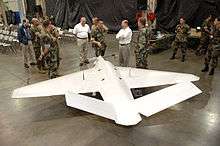
DEVGRU's full mission is classified but is thought to include preemptive, pro-active counter-terrorist operations, counter-proliferation (efforts to prevent the spread of both conventional weapons and weapons of mass destruction), as well as the elimination or recovery of high-value targets (HVTs) from unfriendly nations.[32][33] DEVGRU is one of a handful of U.S. Special Mission Units authorized the use of preemptive actions against terrorists and their facilities.[34]
When SEAL Team Six was first created in 1980 it was devoted exclusively to counter-terrorism with a worldwide maritime responsibility; its objectives typically included targets such as ships, oil rigs, naval bases, coastal embassies, and other civilian or military bases that were accessible from the sea or inland waterways. On certain operations small teams from SEAL Team Six were tasked with covertly infiltrating international high risk areas in order to carry out reconnaissance or security assessments of U.S. military facilities and embassies; and to give advice on improvements in order to prevent casualties in an event of a terrorist attack. SEAL Team Six was disbanded in 1987, and its role, minus non-CT ship-boarding which was given to the newly formed SEAL Team 8, given to the newly formed DEVGRU.[35]
Since the start of war on terrorism, DEVGRU has evolved into a multi-functional special operations unit with a worldwide operational mandate. Such operations include the successful rescue of Jessica Buchanan and Poul Hagen Thisted, the attempted rescue of Linda Norgrove, the successful rescue of American doctor Dilip Joseph[36] and in 1991, the successful recovery of Haitian President Jean-Bertrand Aristide and his family during a coup that deposed him.
The official mission of the currently operating Naval Special Warfare Development Group mission is "to provide centralized management for the test, evaluation, and development of equipment technology and Techniques, Tactics and Procedures for Naval Special Warfare".[37]
DEVGRU and the Army's Delta Force train and deploy together on counter-terrorist missions usually as part of a joint special operations task force (JSOTF).[5][12][38][39]
The Central Intelligence Agency's highly secretive Special Activities Division (SAD) and more specifically its elite Special Operations Group (SOG) often works with, and recruits from, DEVGRU.[40] The combination of these units led ultimately to the killing of Al-Qaeda leader Osama bin Laden in Operation Neptune Spear.[41][42][43]
Controversies
Death of Linda Norgrove
A joint investigation by the British and American governments into the failed hostage rescue operation which was led by DEVGRU that resulted in the death of the British aid worker Linda Norgrove concluded that Norgrove was accidentally killed by a grenade thrown by a member of Seal Team Six.[44][45] Navy SEALs did not immediately notify senior officers about throwing the grenade; this breached military law,[45] and a number of sailors were disciplined.[45]
Death of Logan Melgar
On June 4, 2017, US Green Beret Staff Sergeant Logan Melgar was found killed by asphyxiation in Mali, in the US embassy's housing he shared with a few other Special Operations members on duty in Mali.
Shortly after the murder two unnamed members of DEVGRU were flown out of Mali and placed on administrative leave as persons of interest to the Naval Criminal Investigative Service.[46][47] By February 2018, the strangulation had prompted a broad internal military audit and investigation of SEAL Team Six. This investigation has named the two DEVGRU members who are persons of interest in the homicide and has initially focused on analyzing their conflicting statements regarding Melgar's death. While they had stated that Melgar had been intoxicated on the evening of his death, he was determined to have no drugs or alcohol in his system when he died. Melgar was further determined to have had his throat and upper body mutilated in an apparent attempt at a tracheotomy. The two DEVGRU members stated that they found Melgar unconscious and not breathing and that they tried to perform an emergency tracheotomy on him. One of the DEVGRU members has subsequently stated that he accidentally choked Melgar during a practice match. A continued focus of the investigation was allegations that Melgar had discovered that the two DEVGRU members had stolen cash earmarked for paying local informants and that he had told the two that he would report that. The two DEVGRU members deny this allegation.[48]
In November 2018, two Navy Seals, Petty Officer Anthony E. DeDolph and Chief Petty Officer Adam C. Matthews, along with two Marine Raiders, Gunnery Sgt. Mario Madera-Rodriguez and Staff Sgt. Kevin Maxwell Jr., were charged with felony murder of Logan Melgar, and other crimes. On May 17, 2019 Chief Petty Officer Matthews was sentenced to one year's detention in a military prison after having pleaded guilty and agreed to testify in the cases against the other defendants.[51] On June 7, 2019 Staff Sgt. Kevin Maxwell Jr. was sentenced to four years' detention after having pleaded guilty.[52]
See also
- 1st Special Forces Operational Detachment – Delta (USA)
- Alpha Group and Vega Group (Russia)
- Special Boat Service (UK)
- Commandos Marine (France)
- Joint Task Force 2 (Canada)
- JW GROM (Poland)
- Navy SEALs in popular culture
- List of Navy SEALs
Notes
- "SEAL Team 6 by the Numbers – Foreign Policy". 28 July 2015. Archived from the original on 28 July 2015. Retrieved 10 June 2017.CS1 maint: BOT: original-url status unknown (link)
- Brook, Tom Vanden (16 May 2016). "Navy SEALs' secret medals reveal heroism over last 15 years". Navy Times. Retrieved 1 January 2017.
- von Rosenbach, Alexander (4 May 2011). "Devgru: Bin Laden's ultimate nemesis". IHS Jane's Defense & Security Intelligence & Analysis. Archived from the original on 9 May 2011. Retrieved 18 June 2013.
Devgru was established in 1987 as the successor to SEAL Team 6 (although it is still colloquially known by this name). The unit serves as the US Navy's dedicated counter-terrorism unit and is believed to consist of about 200 personnel.
- Naylor, Sean. Relentless Strike. Chapter 4.CS1 maint: location (link)
- Emerson, Steven (13 November 1988). "Stymied Warriors". The New York Times Magazine. Retrieved 13 March 2008.
- https://nationalinterest.org/blog/buzz/us-armys-delta-force-how-secret-group-deadly-soldiers-came-be-55057
- "In high demand, Air Force commandos must find new ways to cope with stress of duty". The Gaffney Ledger. Gaffney, South Carolina. Associated Press. Retrieved 4 May 2013.
- Fallows, James (13 December 1981). "Iran from five American viewpoints". The New York Times.
- Halloran, Richard (26 November 1986). "U.S. moving to expand unconventional forces". The New York Times. Retrieved 7 May 2011.
- Marcinko, Richard (1992). Rogue Warrior. New York: Pocket Books. ISBN 978-0-671-79593-1.
- Pfarrer, Chuck (2011). SEAL Target Geronimo: The Inside Story of the Mission to Kill Osama Bin Laden. Macmillan. p. 178. ISBN 978-1-4299-6025-0.
- Gerth, Jeff; Philip Taubman (8 June 1984). "U.S. military creates secret units for use in sensitive tasks abroad". The New York Times.
- Wasdin, Howard (9 May 2011). "'SEAL Team Six' And Other Elite Squads Expanding". NPR. Retrieved 19 May 2011.
- "Naval Special Warfare Development Group (DEVGRU)". Global Security. Retrieved 18 June 2013.
- Ambiner, Marc (10 October 2012). "Delta Force Gets a Name Change". The Atlantic. Retrieved 18 June 2013.
- Abhan, Courtney Messman (30 July 2010). "Special Warfare Development Group seeks Sailors" (PDF). Naval Station Everett Public Affairs. Northwest Navigator. p. 3. Retrieved 14 September 2012.
NSWDG is located in Virginia Beach, and is a type two sea duty cno priority one major command. The command is an elite counter terrorism unit that conducts research, and develops, tests, and evaluates current and emerging technology. This technology is related to special operations tactics and joint warfare to improve Special Forces war fighting capabilities. ... While at NSWDG, support personnel could have opportunities to earn many special qualifications, their expeditionary warfare specialist (EXW) pin, and Combat Service Support and Combat Support Naval Education Codes (NEC). Special qualifications include parachuting and fast roping, among many others. NSWDG support personnel receive special duty pay, and have some of the highest promotion rates in the Navy.
- Anderson Cooper (3 May 2011). "'This is their type of op,' ex-SEAL says". CNN.
- Pfarrer, Chuck (2004). Warrior Soul: The Memoir of a Navy Seal. New York: Random House. pp. 325–26. ISBN 978-0-89141-863-4.
In one year, the operators of SEAL Six fire more bullets than entire USMC.
- "The iron will of Seal Team 6". CBS News. 6 May 2011. Retrieved 19 May 2011.
- "LCV Cities Tour: Interview with Howard Wasdin 'SEAL Team Six: Memoirs of an Elite Navy SEAL Sniper'". Global-report.org. 22 June 2011. Retrieved 7 January 2012.
- Pfarrer, Chuck (2004). Warrior Soul: The Memoir of a Navy Seal. New York: Random House. pp. 325–26. ISBN 978-0-89141-863-4.
editions:PanKDPddlTQC.
- Owen, Mark (2012). No Easy Day. Dutton Adult. p. 11. ISBN 9780525953722.
- Owen, Mark (2012). No Easy Day. Dutton Adult. p. 37. ISBN 9780525953722.
- Combs, Cindy C; Slann, Martin W. (2007). Encyclopedia of Terrorism. Infobase Publishing. p. 289. ISBN 978-0-8160-6277-5.
- Blehm, Eric (2013). Fearless: The Undaunted Courage and Ultimate Sacrifice of Navy SEAL Team SIX Operator Adam Brown. WaterBrook Press. ISBN 9780307730701.
- "SEAL Team 6 by the Numbers". Foreign Policy. Retrieved 10 June 2017.
- Butler, Frank K.; John H. Hagmann; David T. Richards (2009). Tactical Management of Urban Warfare Casualties in Special Operations. Parabellum Concepts. p. 6.
- Naylor, Sean (2006). Not a Good Day to Die: The Untold Story of Operation Anaconda. Penguin. p. 253. ISBN 978-0-425-20787-1.
- "Rear Admiral Edward G. Winters, III". United States Navy. 30 June 2011. Retrieved 5 February 2012.
- "Rear Admiral Brian L. Losey". United States Navy. 18 November 2014. Retrieved 11 October 2015.
- "2 SEALs killed in Afghanistan fighting". Navy Times. Associated Press. 15 September 2008. Retrieved 11 October 2015.
"The deaths of SOCS Marcum and SOC Freiwald are tremendous losses for Naval Special Warfare and the United States," Capt. DeAaron Vankeuren, commanding officer of Naval Special Warfare Development Group, said in a statement.
- Shanker, Thom; Risen, James (12 August 2002). "Rumsfeld weighs new covert acts by military units". The New York Times. Retrieved 7 May 2011.
- "Frequently Asked Questions". LT Michael P. Murphy USN. United States Navy. Archived from the original on 9 April 2008. Retrieved 20 May 2008.
- U.S. Special Ops: America's Elite Forces in the 21st Century, Fred J. Pushies, MBI Publishing Company, 2003.
- "DEVGRU". americanspecialops.com. Retrieved 9 February 2018.
- Qadir Sediqi,"U.S. Navy SEAL killed in operation to rescue American doctor in Afghanistan". CNN. 10 December 2012
- http://jsou.socom.mil/JSOU%20Publications/2015SOFRefManual_final_cc.pdf
- Couch, Dick (2005). The Finishing School: Earning the Navy SEAL Trident. Three Rivers Press. ISBN 978-0-609-81046-0.
- Bowden, Mark (2001). Black Hawk Down: A Story of Modern War. Signet. ISBN 978-0-451-20393-9.
- Waller, Douglas (3 February 2003). "The CIA's Secret Army". Time. http://www.time.com/time/magazine/article/0,9171,1004145-1,00.html
- "Osama bin Laden killed in CIA operation". The Washington Post. 8 May 2011. Retrieved 19 May 2011.
- Naylor, Mark Mazzetti, Nichols Kulish, Christopher Drew, Serge F. Kovaleski, Sean D.; Ismay, John (6 June 2015). "The Secret History of SEAL Team 6: Quiet Killings and Blurred Lines". The New York Times. ISSN 0362-4331. Retrieved 6 June 2015.
- https://www.washingtontimes.com/news/2013/jun/7/the-betrayal-of-the-navys-seal-team-6
- Harding, Thomas (15 February 2011). "Mistakes by US special forces led to death of aid worker Linda Norgrove, inquest finds". The Daily Telegraph.
- "Aid worker Linda Norgrove was killed by US grenade". BBC News. 2 December 2010.
- Schmitt, Eric (29 October 2017). "2 Navy SEALs Under Suspicion in Strangling of Green Beret in Mali". The New York Times. Retrieved 18 November 2017.
- Nichols, Hans; Gains, Mosheh (13 November 2017). "Witness: Navy SEAL Said He 'Choked' Green Beret Who Died". nbcnews.com. Retrieved 24 November 2017.
- Cole, Matthew (7 February 2018). "U.S. Military Launches Broad Investigation of SEAL Team 6 After Green Beret Killing in Mali". The Intercept. Retrieved 9 February 2018.
- "Navy SEAL gets prison time for role in Green Beret's hazing death". Retrieved 9 September 2019.
- "Marine Sentenced to 4 Years for Role in Logan Melgar Homicide". Retrieved 9 September 2019.
References
- Gormly, Robert A. (1999). Combat Swimmer: Memoirs of a Navy SEAL. New York: Penguin Group. ISBN 978-0-451-19302-5.
- MacPherson, Malcolm (2006). Roberts Ridge: A Story of Courage and Sacrifice on Takur Ghar Mountain, Afghanistan. New York: Bantam Dell. ISBN 978-0-553-58680-0.
- Shipler, David K.; Halloran, Richard (26 November 1985). "Terror: Americans as targets". The New York Times. Retrieved 7 May 2011.
| Wikimedia Commons has media related to United States Naval Special Warfare Development Group. |
